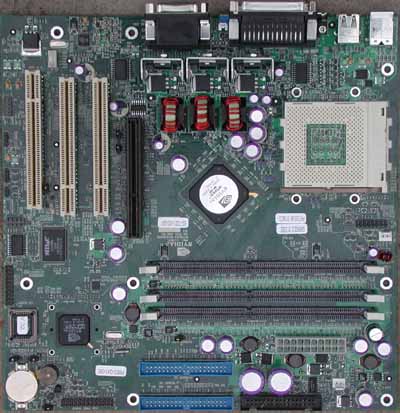NVIDIA's nForce 420/220: It's finally here
by Anand Lal Shimpi on September 24, 2001 8:26 AM EST- Posted in
- CPUs
nForce: The Reference Board
In our original article we described the two major incarnations of the nForce chipset, the nForce 220 and the nForce 420. The only difference between the two is the presence (or lack thereof) the TwinBank memory controllers; the nForce 420 uses the 128-bit TwinBank memory controllers and thus has the IGP-128 while the nForce 220 has the 64-bit IGP-64. Another designation is made among chipsets based on the presence of the Dolby Digital license for the MCP. Appending a "-D" to the end of the chipset name indicates that a MCP-D is present while no trailing D indicates that Dolby Digital Encoding will not be available.
NVIDIA's reference board is a very well constructed implementation of the nForce 420-D chipset. The 4-layer microATX motherboard is intended to show off how cheap nForce motherboards can be made because of their 4-layer construction and ability to maintain fully functionality while being confined to a microATX form factor. The board features two PCI slots, 1 AGP slot and 1 ACR slot (the backwards PCI slot on the board).
Since the reference board does use the 420 chipset, there are two independent memory banks present. The first is a single 184-pin DDR SDRAM bank and the second is a combination of two 184-pin DDR SDRAM banks. In order for you to take advantage of the two memory controllers a DIMM must be present in the single bank and one DIMM must be present in one of the two remaining slots. Otherwise the motherboard will default to 64-bit operation, effectively making this board a 220-D.
There are a few notable shortcomings about the reference board. First of all, there is no Ethernet physical layer on the motherboard itself and thus no Ethernet header. The Ethernet controller was enabled in the MCP-D and drivers could be installed but there was no way to test the Ethernet performance due to the lack of an Ethernet header. Fortunately, most motherboard manufacturers seem to be outfitting their nForce boards with an Ethernet header.
The other problem is that in spite of the "-D" designation on the MCP, the motherboard features no digital output connector. The only audio ports are the conventional speaker out and the line/mic inputs. According to NVIDIA, a separate ACR card is necessary to gain the digital output necessary for outputting a Dolby Digital encoded signal. We sincerely hope that when the big-five manufacturers come forth with their nForce solutions that they make it a point to either include the appropriate ACR card or some other means of having a digital output connector otherwise one of the biggest features of the chipset will have gone to waste.
Because of these two issues with the reference design, we were not able to test the Ethernet performance of the solution nor its ability to achieve real time Dolby Digital encoding. We did test the basic audio functionality however.











1 Comments
View All Comments
Dr AB - Sunday, May 10, 2020 - link
Max Payne - Brings a lot of good memories from that era. Running it at 1024x768 at max quality and getting ~30 fps? Really impressive for a iGPU of that time.I remembr playing it on Pentium III 500 with ATI Radeon Pro AGP 2X 4MB. Performance was really terrible due to texture swapping .. even at 800x600.